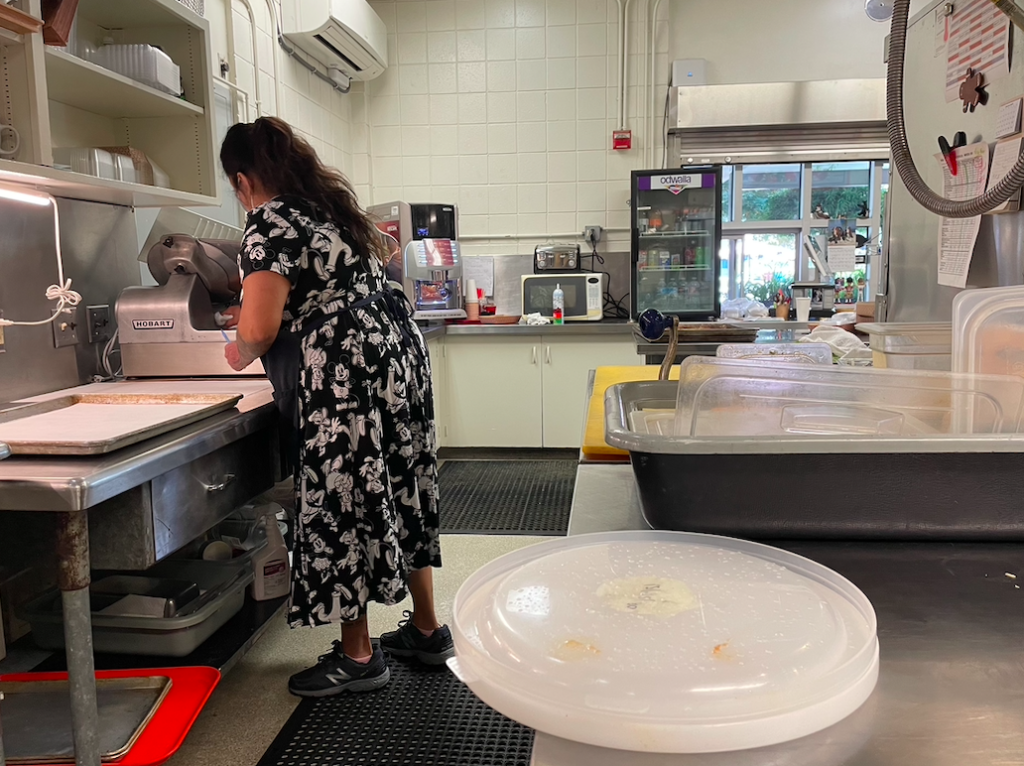As the cafeteria reopened this year at full capacity during the pandemic, new safety policies and procedures have been put in place.
District cafeteria head Pam Carlino has introduced a system that has 12 cafeteria employees, not including herself, rotating between the Saratoga and Los Gatos campuses. That way, if one cohort comes in contact with COVID-19, the other cohort will still be able to continue providing lunches.
Like students, the cafeteria staff must also check in every day on Screener-19 to track potential COVID-19 transmissions. Additionally, despite the school installing a new ventilation system to increase airflow in the cafeteria, staff must still keep their mask on at all times indoors in accordance with Santa Clara County policy.
“Even though it’s in a mask, I’m just so happy to be back on campus,” Carlino said.
In addition to new staffing procedures, the cafeteria follows new lunchtime guidelines. For instance, the cafeteria removed the soup and salad options in favor of grab-and-go food items to limit contact, decreasing risk of infection for students and staff.
Additionally, indoor eating is now prohibited; the Student Center, Wellness Center and the inside of the cafeteria are closed to all students and staff for eating. Although understandable, this decision has elicited disappointment among students who have struggled with finding places to sit in limited outdoor space.
“It was convenient to sit in the Student Center, but now there isn’t enough room for everyone to sit at a table outside,” junior Dyne Lee said.
Student disappointment, however, has been offset by the cafeteria’s efforts to improve the quality of its food. This year, the cafeteria staff recruited a new chef, Paul Boundas, through the school’s partnership with the Country House program, a lunch program founded by Boundas that helps schools revamp their food offerings. Boundas was called a “Miracle Worker” by the Chicago Tribune for making nutritious, delicious food on a tight budget.
The school previously worked with the catering company Sodexo as a way to save money on food, but switched to working with Country House because previously, Carlino said, “nobody was happy with the food.”
Carlino said the price of food has slightly increased with the better quality.
Assistant principal Matt Torrens said that, because of its students’ average household income level, Saratoga High doesn’t qualify as a Title I school, where free lunches are given out to all students. In fact, funding for the cafeteria comes entirely from district and taxpayer dollars because the school is not part of the National School Lunch Program that subsidizes lunches and does not receive government funding.
As in previous years, students whose families are having trouble financially can participate in a confidential school program that allows students to receive free lunches. Principal Greg Louie and Carlino have also discussed the idea of providing lunch to students who participate in summer learning on campus, but this idea is still undergoing development.
Due to the nature of the pandemic, there have been many changes made to the cafeteria system and employees and students are still adjusting to the new guidelines.
“Everybody is just trying to navigate through all the new ways of living, you know?” Carlino said. “That’s a big challenge, but we’re pushing through it.”


























